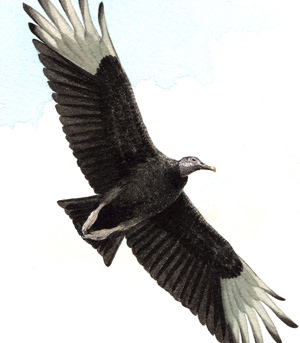Find a Bird
Black Vulture
Coragyps atratus

Very local and likely increasing
“It is a foul carrion feeder, even more so than the Turkey Vulture. Carrion, offal, ordure, and filth attract it.” – Edward Howe Forbush, The Birds of Massachusetts and Other New England States
Black Vultures have not historically been associated with Massachusetts. Instead, these birds have long been one of the common scavengers throughout most of Central and South America, as well as in the Southern United States. Black Vultures are still a rare sight in Massachusetts compared with the familiar Turkey Vultures, but these canny clean-up crews are not ones to pass up a fresh, or rotten, meal wherever it appears. Their preference for nesting in difficult-to-reach rock- and boulder-strewn talus slopes or outcrops makes them a hard species to confirm, but an increasing presence in southwestern Massachusetts is suggestive of regular nesting.
Historic Status
The first Black Vulture identified in Massachusetts was shot in Swampscott in November of 1850. The second appeared in Gloucester on September 28, 1863, where it, too, was killed (Howe & Allen 1901). Throughout the next century, the bird was considered an accidental straggler in Massachusetts; and, by the middle of the nineteenth century, the species was on the move from its deep Southern roots, breeding in southern Maryland for the first time in 1922 (Court 1924) and in Pennsylvania by 1952 (Brauning 1992).
Atlas 1 Distribution
This species was not recorded in Atlas 1 (1974-1979), but in June of 1998, Norman Smith discovered a nest on a rocky ledge in the Blue Hills, Milton, where adult Black Vultures had been regularly seen soaring for some time previously (Petersen & Meservey 2003). Unlike the events during the species’ earlier forays into the state, these birds nested without disturbance, and the first Black Vulture known to have hatched in Massachusetts took flight on August 2. In the years following, Black Vultures became more common as summer visitors, especially in the southwestern part of the state.
Atlas 2 Distribution and Change
In Atlas 2 Black Vultures continued to be observed in the southwestern reaches of the state, primarily in the southern Marble Valleys and the Lower Berkshire Hills, with a handful of other sightings east through the Coastal Plains. Black Vultures evaded Confirmation during the Atlas period, but they were almost certainly breeding somewhere in western Massachusetts during that time.
Atlas 1 Map

Atlas 2 Map

Atlas Change Map

Ecoregion Data
Atlas 1 | Atlas 2 | Change | ||||||
Ecoregion | # Blocks | % Blocks | % of Range | # Blocks | % Blocks | % of Range | Change in # Blocks | Change in % Blocks |
Taconic Mountains | 0 | 0 | 0 | 0 | 0.0 | 0.0 | 0 | 0.0 |
Marble Valleys/Housatonic Valley | 0 | 0 | 0 | 4 | 10.3 | 33.3 | 4 | 10.3 |
Berkshire Highlands | 0 | 0 | 0 | 0 | 0.0 | 0.0 | 0 | 0.0 |
Lower Berkshire Hills | 0 | 0 | 0 | 2 | 6.5 | 16.7 | 2 | 7.4 |
Vermont Piedmont | 0 | 0 | 0 | 0 | 0.0 | 0.0 | 0 | 0.0 |
Berkshire Transition | 0 | 0 | 0 | 2 | 5.0 | 16.7 | 1 | 3.2 |
Connecticut River Valley | 0 | 0 | 0 | 1 | 1.5 | 8.3 | 1 | 2.1 |
Worcester Plateau | 0 | 0 | 0 | 0 | 0.0 | 0.0 | 0 | 0.0 |
Lower Worcester Plateau | 0 | 0 | 0 | 1 | 1.3 | 8.3 | 0 | 0.0 |
S. New England Coastal Plains and Hills | 0 | 0 | 0 | 2 | 0.7 | 16.7 | 2 | 0.9 |
Boston Basin | 0 | 0 | 0 | 0 | 0.0 | 0.0 | 0 | 0.0 |
Bristol and Narragansett Lowlands | 0 | 0 | 0 | 0 | 0.0 | 0.0 | 0 | 0.0 |
Cape Cod and Islands | 0 | 0 | 0 | 0 | 0.0 | 0.0 | 0 | 0.0 |
Statewide Total | 0 | 0.0 | 0.0 | 12 | 1.2 | 100.0 | 10 | 1.2 |
Notes
Black Vulture shows significant increasing Breeding Bird Survey trends, both in the mid-Atlantic region and the whole Eastern US. Many of the wide-ranging foraging species, for instance Great Blue Heron, Turkey Vulture, and Black Vulture will be noted during Safe Dates in blocks where they do not breed. Eliminating blocks where the species is simply seen once during Safe Dates gives a better idea of these species’ breeding footprints. But given the vultures remote and secretive nature during breeding, using Confirmations only can also be misleading. The failure to confirm the species is not surprising given the secretive habits of breeding of vultures, but it seems likely that at the least Black Vultures are on their way to becoming breeders in the Commonwealth. It is also fair to say that Atlas methods are a “blunt tool” to use for determining vulture breeding populations.



